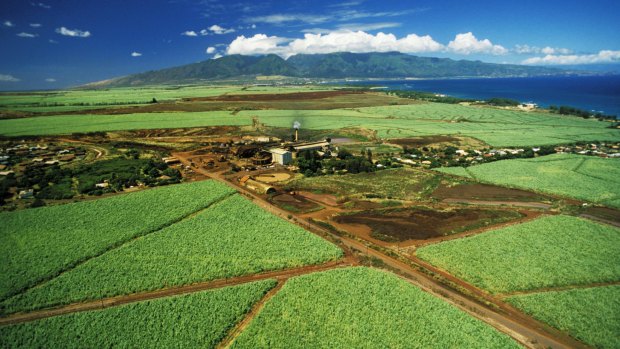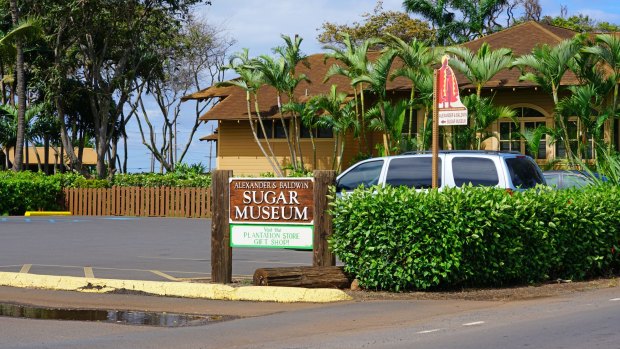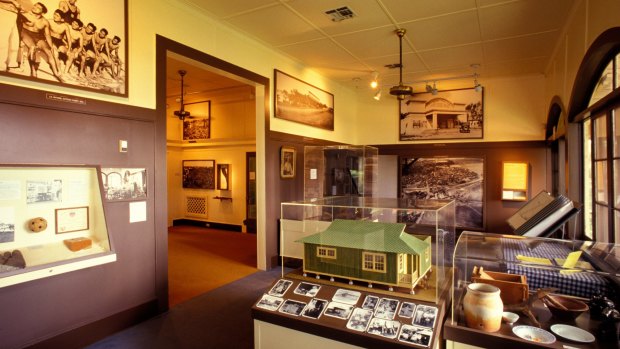This was published 4 years ago
Sugar Museum, Maui, Hawaii: The surprising role sugarcane play in Hawaii's history
By Steve Meacham

Cane fields and sugar mill at Paia Maui.Credit: Alamy
Sugar shaped Hawaii, almost as much as those volcanoes, pounding Pacific ocean waves and hurricanes.
It was American sugar barons who launched the coup d'etat against Queen Lili'uokalani in 1893, ensuring one of the world's most remote archipelagos would be annexed by the US the following year.
It was sugar that brought about modern Hawaii's exquisite ethnic mix. Each new wave of impoverished immigrants – from China, Japan, Portugal, the Philippines and Afro-Americans from the mainland – lured to Hawaii to work in the cane fields for subsistence wages have left their mark, not least on the island's cuisine.

Alexander & Baldwin Sugar Museum, on the outskirts of Kahului, Maui.Credit: Shutterstock
And it was sugar that produced the rum that gave us the Hawaiian cocktails (Mai Tai, Blue Hawaii, Captain's Demise,Tropical Itch, to name a few) which make our holidays so much more enjoyable.
Yet today there's no commercial sugar industry, apart from a few cane fields which service boutique rum distilleries. The last, and biggest, sugar plantation and mill closed in 2016.
At its peak, Alexander & Baldwin, on the outskirts of Kahului, Maui's largest town, had 15,000 hectares of sugarcane under cultivation. It employed hundreds of men, women and children doing back-breaking work in relentless sun and rain – both weather conditions are needed to grow sugar.

Exhibits tell the history of the sugarcane industry at the Alexander and Baldwin Sugar Museum.Credit: Alamy
Now all that remains of Alexander & Baldwin, apart from a rusting processing plant, is the mill superintendent's home. It's been converted into the Sugar Museum, which is the only place in Hawaii where you'll learn how important this single crop was to the US economy, eventually turning Hawaii into the 50th state.
Most visitors to Maui know Kahului – if at all – as a port of entry. Because Kahului has both Maui's airport and cruise terminal, it's usually a place tourists speed through on their way to the island's world-famous attractions.They include the quaint charm of Lahaina, Hawaii's former capital; the beaches from Kaanapali to Napili Bay: the switchback and picturesque Road to Hana; and snorkelling with the turtles off Molokini island.
Nobody usually spends their single day in Maui in Kahului (apart from those who feel the best part of a cruise is visiting a different mall). But having been to Maui before, I turned down the various shore excursions, preferring to explore on foot what Kahului has to offer.
That the sugar museum exists is wonderful, but it could be so much better. Sure, you'll learn how sugarcane is believed to have originated in New Guinea, before spreading to south-east Asia, India, Europe and – via Christopher Columbus – to the West Indies. There, like cotton, sugar became synonymous with slavery.
Sugarcane reached Hawaii around 1000 years ago, but it wasn't grown commercially until 1835 when the first sugar plantation was established on Kauai. Within a decade there were 80 plantations spread around the main islands, feeding America's sweet-toothed obsessions.
Two childhood friends, Samuel Alexander and Henry Baldwin, began their plantation in 1848 and the museum does a good job of explaining their engineering marvels, especially the irrigation canals which transferred water from the other rainy side of the mountain to the arid flat land they had purchased.
Vast fortunes were made, with "the sugar barons" growing so economically powerful they could usurp the royal family and turn a proud island nation into a cheap offshore colony. By far the most interesting part of the sugar museum is the social history.
The staple food of most workers was bread and rice. But each new wave of immigrants brought aspects of their own culture to the "plantation settlements" where they were housed, away from native Hawaiians, who were too wise to work for nothing. The Portuguese – mainly from the similarly remote Azores – built their clay ovens, baking breads and pastries; Filipinos introduced cock-fighting; the Japanese gathered in their few spare hours to watch sumo wrestling.
Layer by layer, sugar added cultural complexity to Hawaii's physical wonders. So, despite sour origins, the result is sweet.
TRIP NOTES
Steve Meacham was a guest of Norwegian Cruise Line.
MORE
CRUISE
Norwegian Cruise Line's Pride of America visits four Hawaiian islands in a seven-day cruise departing and returning every Saturday. See ncl.com
TOUR
Alexander & Baldwin Sugar Museum. See sugarmuseum.com
Sign up for the Traveller Deals newsletter
Get exclusive travel deals delivered straight to your inbox. Sign up now.